The Pinniped Rehabilitation Pathway: From Rescue to Release at CWC
Read this pictorial story about the rescue and release of a malnourished California Sea Lion pup found on a busy beach
Read this pictorial story about the rescue and release of a malnourished California Sea Lion pup found on a busy beach
By: Heather Henderson, Marine Mammal Program Manager
Marine mammal strandings have a somewhat predictable pattern – spring and summer are extremely busy! A sharp bell curve of activity to be precise. Winter and fall months are generally slower seasons, as we respond to the rhythms of nature and the birthing calendar of our native species. There are fewer rescue calls received during the fall months in SoCal, and we close for rehabilitation during the winter. We are often asked, “what do you do when there are no patients on-site?” The reply – reflect, improve, and prepare for the next busy stranding season.
Once the enclosures are empty, annual maintenance becomes top priority. The marine mammal staff and volunteers stay busy rebuilding, repairing, deep cleaning, training, and doing quality control on data entry. The most intense aspect of repairing revolves around performing safety checks in every nook of the enclosures, carriers, and rescue gear so that we may be prepared for the busy months.
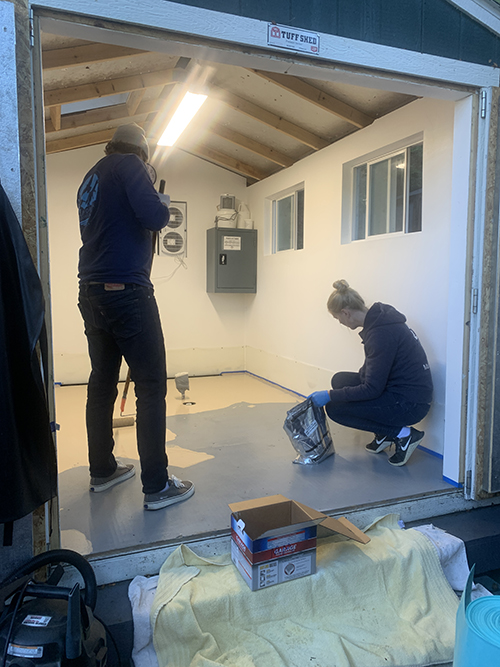
Exam Room Painting

Kevin Fixes the Wall

Rick Prepping Floor
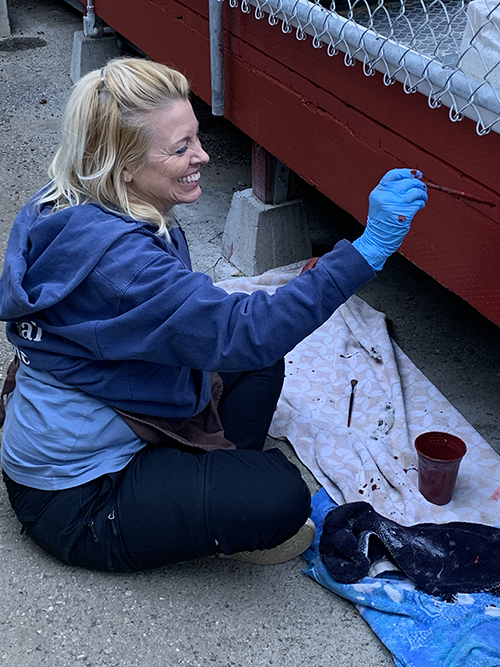
Joanna Paints
2023 did not follow the usual normal pattern of ramping down during June and July. On the contrary, due to the Domoic Acid Crisis experienced by California sea lions during the summer months, patients were kept in-house through mid-September. It was wonderful to have the opportunity to assist dozens of additional patients, but it abbreviated the time available to complete off season projects and repairs.
Projects include laying new flooring, freshening up and protecting the areas with a coat of paint, and replacing all the valves throughout the marine mammal enclosures and pool filtration system. In addition to performing necessary repairs, project season is a time for our crews to meet new volunteers and forge new friendships.
The volunteer family at California Wildlife Center is comprised of an amazing and diversely talented group of people. It is easy to see why they choose to be involved when beautiful seals and sea lions are around, but the true expression of their commitment shines during the fall, when this devoted team is focused on improving our facility in order to be ready to offer the best care possible to stranded marine mammals in Malibu.
By Marine Mammal Program Manager, Heather Henderson

California Sea Lion on Beach
You may have seen California sea lions in the news recently. Starting in June, we have been experiencing an increase in sick sea lion calls all along the Southern California coast. What has caused this?
Upwelling ocean currents along the Southern California coastline bring nutrient-rich water to the surface. The upwelling mixes deep, cool water with warmer sea surface water, resulting in an explosion of growth when sunlight is present, supporting a wide diversity of ocean life. Along with healthy growth, toxic algal blooms can also flourish. Fed by fertilizer runoff, these poisonous blooms can experience dynamic growth.
Pseudo-nitzschia is a single celled plant that has a non-toxic and toxic variety. Concentrations build up in filter feeding fish and shellfish that are consumed by California sea lions. When in the toxic form, Pseudo-nitzschia is referred to as Domoic Acid and acts as a neurotoxin. The result on the body when ingested can vary from abnormal behavior to full-body seizures, and even death. As a sentinel species, sea lions are telling us (and lab analysis has confirmed) that Domoic Acid is at unusually high levels in the Pacific. In early June, we saw the beginning of this historic mass poisoning event.
The Domoic Acid bloom synced with the pregnancies of the California sea lions, as the majority give birth in June. To prepare for nursing their newborns, pregnant females consumed dozens of pounds of fish daily, bulking up and staying in top shape. However, this June, instead of traveling out to the Channel Islands, hundreds of adult females and their pups were knocked off course. After consuming large quantities of the neurotoxin, they ended up stranded on the mainland beaches, experiencing disorientation, seizures, and even dying as a result of consuming large quantities of contaminated fish.
During the five most severe weeks of this event, CWC’s marine mammal team fielded over 800 reports of stranded California sea lions, performing 125 responses in Malibu. By comparison, a normal year will yield on average 15 responses during the same five-week timeframe.
What are the main challenges that accompany the response to a large toxic algal bloom? It arrives with little to no warning and intensifies within just a few days. Rescue programs quickly reach maximum capacity and are unable to admit every stranded animal as a patient, so triage and beach monitoring are implemented.
Can sea lions survive this massive assault on their bodies? The fortunate answer is yes! Although a mentally and physically difficult time, there were numerous successes to celebrate throughout this event. All patients currently in care are no longer displaying seizure activity and are self-feeding. 75% of the California sea lions rescued during this event survived and have been released or are on track to be released.
Harbor seals are found in nearly every ocean across the globe. There are even two local sites in Malibu that support year-round populations, and yet our Marine Mammal Rescue Team receives only one or two reports per year about a harbor seal in distress. How can this be? Pacific harbor seals (Phoca vitulina) are very shy and go to great lengths to keep their distance from humans.
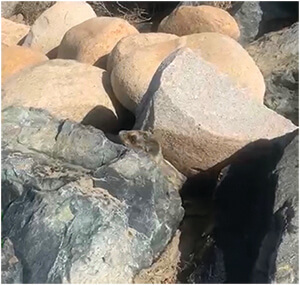
Yellow Tagged Sea Lion Hiding in the Rocks on Westward Beach
By Heather Henderson, Marine Program Manager
Each winter CWC prepares for the imminent arrival of young sea lion pups in need of help. In nature, California Sea Lions are born in June, with over half of the births occurring on June 15th. This is because sea lions have synchronized reproduction, where individual animals breed, birth, and wean on the same schedule. Ideally sea lion pups should stay with their mothers until April and wean when they are ten months old. While with their mothers, young pups practice fishing and learn important life survival skills.
Unfortunately, not all sea lion pups are able to stay with their mothers until April. Overfishing has led to a decline in available food for sea lions, which often causes mothers to venture farther and farther away looking for fish. This abandonment can force young pups to venture off looking for food, and sometimes they end up on the beaches of Malibu in need of help.
Our first patient of the season was fortunate to be discovered hiding in the rocks on Westward beach. The young female was reported to our Marine Mammal Response Team by a group of caring Malibu residents who were taking advantage of a long awaited warm and clear day. This winter, unseasonably cold days and heavy rains have left local beaches very quiet. Minimal human activity is a positive for healthy wildlife, however it is a drawback for distressed wildlife that may go unnoticed.
The little pup arrived in a malnourished state (weighed only 10.1kgs, which is about 50% of the healthy weight for her age), but with a feisty attitude. This was an encouraging sign that she may respond well to care and be able to return to the wild after her stay in rehabilitation. An interesting detail: this pup came in already outfitted with identifying yellow flipper tags. Most pups do not have identifying markers at rescue since they are too young to have gone through rehabilitation and release. These yellow flipper tags, and all colors other than orange, are population study tags. From the tags, we now know that she was born on San Miguel Island. At release the yellow tag on her right flipper will be replaced with an orange rehab tag. In California, rehabilitated seals and sea lions are tagged on the right flipper if a female and on the left flipper if a male.
After just a few weeks, yellow tag pup was eating whole fish and beginning to gain weight and strength. She is continuing to improve and is playing with the other pups in our care. California sea lions are a gregarious species and seek out companions. While in care, it is essential that sea lion pups are housed with other pups or older sea lions to promote competition while foraging and deter bonding with humans.
We anticipate that the yellow tag pup may meet a dozen more sea lion pups in the coming weeks. In 2017, which was the most recent severe wet winter in Los Angeles, we stayed busy with the stranding season from January through June. Will this rainy winter prove to be busy for our Marine Mammal Team? Cooler sea surface temperatures that accompany La Nina weather patterns can lead to schools of prey closer to the surface, which is beneficial for newly weaned animals. Yet rough seas and cool rainy conditions quickly exhaust young and weak pups. If you observe a marine mammal that is skinny, injured, small or seems out of place, please do not approach, or touch them – Report to our rescue team. #310 458 WILD. Together we can give them a second chance to thrive!
By Dr. Guthrum Purdin, DVM, Wildlife Veterinarian
In mid-August, California Wildlife Center rescued a sea lion (Zalophus californianus) that had been spotted frothing at the mouth and stuporous. After capture and during transport, full seizures developed. Just a few days later, another sea lion was rescued – this one was weaving their neck and head in a serpentine motion, alternating with what’s called “stargazing” where the head points upward and back, blindly directed toward the sky. Sadly, this was the beginning of a trend, one that would reach up and down the Pacific coast.

Sea lion suffering from DA poisoning, “stargazing”
The culprit was a “harmful algal bloom” (HAB) where a type of diatom, an algal plankton called Pseudo-nitzschia australis, reproduces in massive numbers and produces a toxin called domoic acid (DA). The diatoms are eaten by shellfish and other tiny grazers who are themselves eaten by larger predators. At each step in the food chain, the toxin is concentrated in the animal’s tissues. During one of these HABs, sardines & anchovies, tasty meals for hungry sea lions, may become heavily contaminated with DA, a neurotoxin that can be fatal to marine mammals. Fish eating marine birds, like pelicans and loons, can be likewise affected. Among other properties, DA mimics a certain neurotransmitter called glutamate, activating cells in the nervous system that then can’t be switched off. It also causes calcium to flood into certain cells in the brain, especially the hippocampus and amygdala. Humans exposed to DA may develop Amnesiac Shellfish Poisoning. In animals, the brain, the kidneys, and the heart can be damaged. There is no antidote to this toxin and treatment is supportive: primarily controlling the seizures and providing fluids. Providing good healthy, DA-free food is another key component to treatment.
Problems may persist even after treatment if permanent brain damage occurs. People can have deficits in short-term memory and mood swings. Recovered sea lions have sometimes been found confused, wandering miles away from the ocean.
Way back in 1961, open ocean birds called Sooty Shearwaters appeared at Capitola near Santa Cruz, crashing into people and windows. No one knew what was causing this bizarre behavior and the upsetting event inspired Alfred Hitchcock’s classic horror film “The Birds”. HABs were rare then, but researchers now believe this was an early appearance of DA. Blooms of Pseudo-nitzschia and other toxic plankton are increasing in frequency as ocean temperatures rise. Nutrient runoff from agriculture can further compound the problem.
There are several monitoring stations up and down the coast that keep tabs on concentrations of Pseudo-nitzschia in seawater with the intent of detecting an incipient HAB before it becomes a problem for humans who consume fish and shellfish. Likewise, sea surface temperature is regularly evaluated. In 1987 hundreds of people became ill and three died after consuming DA-contaminated shellfish at Prince Edward Island in Canada. Such large outbreaks have become rare thanks to environmental monitoring. Unfortunately for marine mammals and birds, the vast ocean that is their home and larder can also be a trap when their only food sources become contaminated with toxins like DA.
For now, this year’s harmful algal bloom has passed, and rescue calls have tapered off dramatically. If you see a stranded sea lion on the beach, especially if you suspect something like DA, do not approach the animal. These are wild animals and may behave in unexpected ways. This is especially true with DA, which can cause permanent neurological damage. DA animals can be hyperexcitable and, if they feel threatened, can be very aggressive. So stay back, at least 50ft or more, and notify your local animal control agencies, lifeguards, or a marine mammal rescue organization. Report any unusual behaviors and response teams can evaluate whether the animal is in distress or merely taking a nap after a long day at sea.
By KC Scofield, Stranding Coordinator
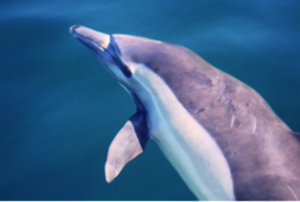
Common Dolphin in the Wild
When walking along the shoreline here in Malibu it is not uncommon to see large Gray Whales feeding in the shallows, charismatic Bottlenose Dolphins playing in the surf, and even a breaching Humpback Whale out in the distance! Large mega-pods of Long and Short Beaked Common Dolphins can frequently be seen from the top of the Point Dume cliff, and Pygmy and Dwarf Sperm Whales thrive in our deeper waters offshore. The Malibu coastline provides a unique habitat to marine mammals both living in the area and just passing through.
Typically, the Marine Mammal department at California Wildlife Center is known for the loud cackles of chatty Elephant Seals or the splish-splashing of playful Sea Lions. While we are most often called to help pinnipeds (seals, sea lions) in need of help, our team also responds to a variety of cetaceans (whales and dolphins) every season.
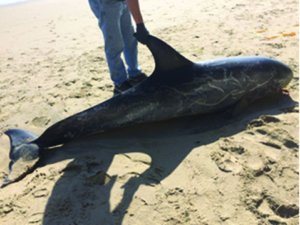
Risso Dolphin
While many species of cetacean strandings are unpredictable, every year like clockwork between November and March we receive calls about Gray Whales. In the fall they migrate south to their breeding grounds in Baja California, Mexico, and in the spring they make the journey north to their summer feeding grounds in the North Pacific (the Bering Sea down to Northern California). This migration “highway” takes them right past Malibu. Many of the reports we receive are not of beached Gray Whales but of those that look “like they are trying to come on shore.” As a coastal species, you can frequently see them feeding in the shallows at Point Dume and Westward beaches. With benthic prey such as shrimp-like amphipods, being their favorite snack, Gray Whales are often seen in very shallow waters rolling on their side, swimming slowly, scooping up sediment, and leaving a trail of mud in their wake. To many, this may look like an animal in distress “trying to come on shore” and in need of help.
The Marine Mammal team responds to all reports that come in, this includes whales and dolphins on shore or in the water. When animals are in the water it provides our team an educational opportunity to share the life history of these local species. We share information like how Gray Whales feed, why dolphins like to surf the waves, and the migratory patterns of Humpback Whales.
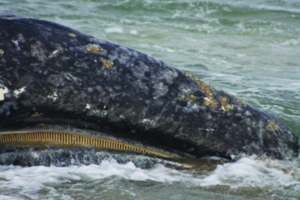
Mouth of Grey Whale
On rare occasions a cetacean may meet the criteria for rescue. If so, the team works together to get the animal off the beach as quickly and safely as possible. On average CWC rescues eight individuals a year. While that may not sound like a lot, these animals require specialized equipment, particular protocols, and quite a few team members since they can be HEAVY (sometimes over 1,000 pounds). So far in 2022 we have responded to two Pygmy Sperm Whales, two Bottlenose Dolphins, one Northern Right Whale Dolphin, and we expect to receive more calls this winter. Other species we have responded to in the past have been, Gray Whales, Risso’s Dolphins, Humpback Whales, Long and Short Beaked Common Dolphins, Striped Dolphins and even a Fin Whale.
The Marine Mammal team responds to all reports that come in, this includes whales and dolphins on shore or in the water. When animals are in the water it provides our team an educational opportunity to share the life history of these local species. We share information like how Gray Whales feed, why dolphins like to surf the waves, and the migratory patterns of Humpback Whales.
On rare occasions a cetacean may meet the criteria for rescue. If so, the team works together to get the animal off the beach as quickly and safely as possible. On average CWC rescues eight individuals a year. While that may not sound like a lot, these animals require specialized equipment, particular protocols, and quite a few team members since they can be HEAVY (sometimes over 1,000 pounds). So far in 2022 we have responded to two Pygmy Sperm Whales, two Bottlenose Dolphins, one Northern Right Whale Dolphin, and we expect to receive more calls this winter. Other species we have responded to in the past have been, Gray Whales, Risso’s Dolphins, Humpback Whales, Long and Short Beaked Common Dolphins, Striped Dolphins and even a Fin Whale.
By Heather Henderson, Marine Program Manager
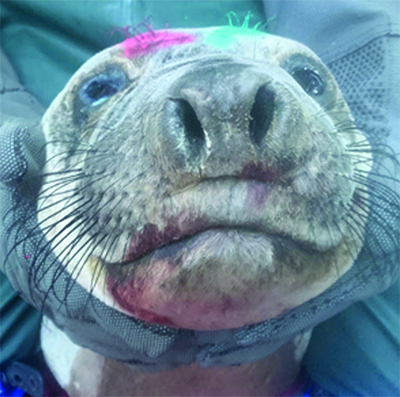
During intake Examination on 5/11/22
On the afternoon of May 11th, patient #22-078 hauled out on Broad Beach in Malibu. Weighing 103 lbs. and measuring just over five feet long, few people might think to call the CWC Marine Mammal Rescue Team out for a wellness check. Fortunately for this four-month-old Northern Elephant Seal pup, a concerned member of the public did just that. When we arrived on the scene, the pup was resting face down near the waters’ edge. Initially he appeared to be a little underweight, but otherwise in fine shape, however something seemed off.
Upon closer examination, the team noticed facial swelling (particularly of the chin and muzzle) as well as moderate dehydration. We elected to pick up the pup and bring him to the center for care. During the intake examination, a stingray barb was discovered at the puncture site on the right lower chin. Once the two-inch-long barb was removed, the area was cleaned, and antibiotics and anti-inflammatory medications were prescribed. The elephant seal was also given supportive fluid therapy. The patient’s stomach was flushed to rule out ingestion of additional foreign substances and fortunately none were discovered.
The elephant seal was improving, but there was persistent swelling on the right side of his muzzle. One of the vibrissae (whisker) follicle endings looked to be infected. The culprit – a second stingray barb! Once removed, the tissue resumed a normal appearance and the vibrissae remained intact. Elephant seals have the most sensitive vibrissae of any animal due to the high number of nerve endings. This adaptation assists with effective prey detection at depth, thus defects in the nerve endings can have an adverse effect on their ability to locate sufficient food. Occasionally we see young elephant seals that encounter stingrays while learning to forage along the sandy ocean floor.

At pre-release Evaluation on 7/6/22
After a week of treatment, the facial swelling began to recede, and patient #22-078 showed an interest in fish. Upon arrival, the Marine Mammal Team had been feeding him a blended liquid nutritional feed. As he recovered, we enlarged his diet to include whole herring.
Pup #22-078 had a pre-release examination on July 5th – the puncture sites were fully healed, body condition was good, and his skin and fur coat were beautiful. This patient was gaining weight daily (an average of one kg/day) and was a robust 200 lbs. (double his intake weight) when he was released back to the Pacific Ocean in mid-July.
The simple act of noticing an ailing animal and taking the time to report them to us gave this seal a chance to heal and thrive. Thank you for caring about wildlife!
By Jenn Guess, Development Manager

Photo by Cambria Wells
2021 was quite a year here at California Wildlife Center (CWC). This past year we had 4,013 animals come to our facility. Our Wildlife Technicians are directly responsible for the care of our patients and every patient that came through our doors was assessed by the technicians in the Intensive Care Unit (ICU). Animals were carefully examined to determine the best course of action for rehabilitation. Sometimes it was as simple as providing fluids and moving the patient to our Orphan Care Unit for supportive care. For adult animals, it was often more complex.
Our ICU technicians didn’t stop after the initial intake exam. They were responsible for the daily care and rehabilitation of thousands of patients during 2021. This was a huge undertaking, especially considering that we continued to operate with minimal help due to the persistence of Covid-19. Our technicians provided extensive wound care, splinted fractures, and administered a complex array of medications to treat infections, reduce swelling, and provide pain management.

Photo by Brittany Moser
Coronavirus did not slow down the influx of new animals showing up each day. Our busiest day was May 31st, where ICU technicians received 42 new patients in one day. The second busiest day was April 26th, with 40 new patients. We always know that Spring and early Summer are the most hectic months there at CWC. From April through June we admitted 1,771 patients, 44% of all animals received for care in 2021. Overall, we saw an increase in the number of patients from 2020. We admitted over 200 more patients in 2021, compared to the previous year. Since opening our doors in 1998, the need for care has increased steadily every year except 2020 (likely due to the arrival of Covid).
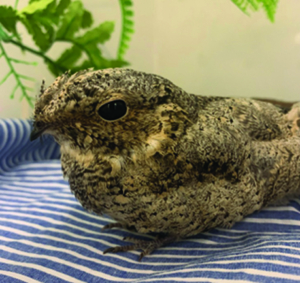
Photo by Jenn Guess
Technicians saw a variety of animals this past year, with 160 different species making their way through our doors. The five most common patients that the ICU technicians examined were, in decreasing order, Eastern Fox Squirrels, Mourning Doves, House Finches, Mallards, and American Crows. Some of the more uncommon species were a Red-breasted Sapsucker, Lesser Scaup, Black-throated Gray Warbler, Western Pond Turtle, and an American White Pelican.
Now that it’s Winter, the ICU technicians are eagerly preparing for the next busy season. In addition to an endless list of smaller tasks, they are deep cleaning the ICU kitchen, repairing enclosures, and reorganizing supplies, all while continuing to perform daily intake exams and care for existing patients on site. It’s a job that is never done, and CWC is very fortunate to have a staff of dedicated technicians who are up for the challenge.
By KC Scofield, Stranding Coordinator

Northern Elephant Seal “Blue” waiting to be rescued
Photo by Joan Zoloth, finder
On March 14th, we rescued an underweight Northern Elephant Seal pup at the La Costa Beach Club in Malibu. Once admitted this pup was marked with a blue non-toxic grease marker used identify individuals while in care, so we began to call him “Blue.” These marks are helpful when telling the seals apart, making it easier to accurately track diets, weight gain, medications, and general progress.
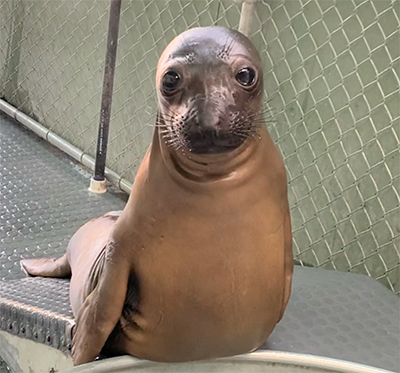
Blue standing tall before going for a swim
Photo by Tara Wilson
We rescued Blue when he was around two or three months old. He was underweight at 86.6 pounds close to what his birth weight would have been. When leaving the rookery, or breeding area, and living on their own, Elephant Seal pups must teach themselves how to swim and fish. This can lead to trouble learning to recognize and swallow fish, a challenge Blue faced during his stay. His learning process was slower than usual, and he had difficulty digesting fish which explains his underweight status and consequent struggle with gaining weight during his stay. The final hurdle for him was an ulcer on his left eye. Blue had a lot to overcome, and the team quickly set to the task of providing him the best care. He received hydration and nutrition via feeding tubes while he was emaciated. Once ready for solid food, we gave him long, thin, easy to swallow fish and put him through “fish school” to help him learn how to track, dive and hunt fish for himself. We treated him with antibiotics and topical eye medications to help stabilize his eye ulcer.
At 12 weeks, his stay became the longest California Wildlife Center has ever had for a marine mammal! This duration was necessary to ensure any challenges were resolved before release. Before release each individual must pass certain milestones. These include reaching a healthy weight goal, proving they can dive, forage, and compete with others for fish, and they must be recovered from the illness or injury that caused them to strand and be free of any secondary health problems. For Blue, the team wanted certainty that his eye was stable and that he could gain and maintain weight. By the morning of his release, he weighed 201 pounds, an average weight gain of 6 pounds per week, bringing him to a healthy weight for a male Elephant Seal pup of his age!

Blue’s attention captured by herring
Photo by Tara Wilson
Elephant Seals typically gather onshore twice a year, in the summer for molting and in the winter for breeding, spending most of their time foraging in the open ocean. Due to this seasonal pattern, the length of his rehabilitation, and the now bustling coastline, a beach release was not an option.
It had been two years since the Marine Mammal Team had done an offshore release. This type of release involved traveling via boat out to the Channel Islands just off the coast. At 5am on June 30th the team started our six-hour journey to Santa Rosa Island. More than two dozen volunteers met us on the dock that morning to celebrate everyone’s hard work and the achievement of releasing Blue.
With the help of Island Packers Cruises, we were able to release Blue off a boat, close to established colonies throughout the Channel Islands. By bringing him further from the mainland and closer to wild seal populations, we could provide him the best chance for success.
Through the overcast June morning and less than calm seas, Blue snoozed most of the three-hour boat ride, peeking occasionally at the ocean ahead of him. Once the boat was situated in a calm area next to the island, the kennel door was opened. With a subtle splash, Blue was back in the Big Blue. He surveyed his new environment, taking it all in, and calmly without hesitation swam away from the boat, out into the ocean. Nestled in the Channel Islands National Park and Marine Protected Area, Santa Rosa Island provides plenty of fish and quiet beaches for Blue to grow and become the best beach master he can be!
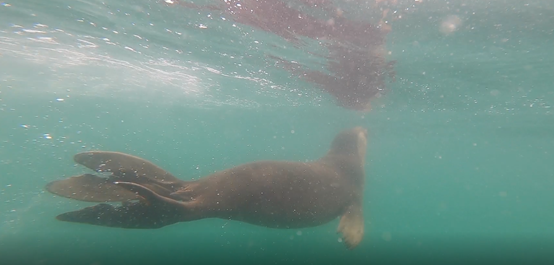
Blue’s release from a boat off of Santa Rosa Island
Photo by Heather Henderson
The Marine Mammal team sincerely thanks our team of volunteers and supporters for their hard work and dedication making this lifesaving work possible.
P.O. Box 2022
Malibu, CA 90265
Hotline Phone: +1 310 458-WILD (9453)
E-mail: admin@cawildlife.org
Enter your email address for the chance to win a private tour of CWC
Your information will never be shared with a third party
